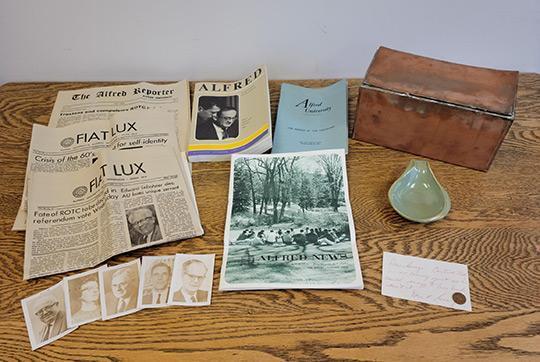Openhym time capsule opening reveals half century-old treasures

A time capsule placed in the cornerstone of Openhym residence hall on the Alfred University campus was opened Tuesday afternoon, revealing a number of items that date back more than 50 years.
ALFRED, NY – A time capsule placed in the cornerstone of Openhym residence hall on the Alfred University campus was opened Tuesday afternoon, revealing a number of items that date back more than 50 years.
Laurie Lounsberry Meehan ’91, University archivist, oversaw the opening of the time capsule in the lobby of Openhym. The capsule—a copper container roughly the size of shoe box—was encased in the cornerstone on the southwest corner of the building; it was removed during renovation work in 2020.
Among the items contained in the capsule: a green ceramic ashtray made in 1968, to commemorate that year’s St. Patrick’s Day celebration; Fiat Lux newspapers from Oct. 8, 1968, and Feb. 14, 1969; an April 1969 issue of the Alfred Reporter, the forerunner to what is now the Alfred alumni magazine; photographs of five recent honorary degree recipients; a Report from the Treasurer for the fiscal year ending June 30, 1968; a University catalog for the 1968-69 academic year; and a 1968 penny. With the penny, Meehan said, was a handwritten note indicating it was placed there by Dan George, possibly a member of the construction crew, or the son of an employee. The note indicated George contributed the coin “so he could brag to his children about it,” Meehan related.
The contents of the Openhym time capsule will be put on display on the main floor of Herrick Library this week.
Meehan gave a brief presentation on the history of the residence hall, named for Alfred University alumna Evelyn Tennyson Openhym ’24, a former University trustee and generous benefactor to her alma mater.
She explained that construction on what would then be called New Women’s Dormitory began in 1967 (the year indicated on the building’s cornerstone) and was completed in 1969. The building, on the south end of campus, was constructed—at a cost of about $1 million—to address a shortage in women’s housing. At the time, men’s and women’s residence and dining facilities were located on opposite ends of campus: men’s dormitories were on the north end, and they ate at Ade Hall; women lived on the south end and dined in the basement of The Brick residence hall. “Not only did the University control your academic life, but it controlled your social life as well,” Meehan explained.
A University-owned house was razed to make room for construction of the residence hall, a four-story contemporary structure made of brick and limestone. The first floor had social and recreational areas, and a suite of rooms, which included the residence of a “house mother.” The second, third, and fourth floors each held 30 single and double occupancy rooms. At the time, the building accommodated living arrangements for just over 150 students.
Openhym enrolled at Alfred University in 1920 and graduated with a degree in ceramic art in 1924. Her mother attended the Alfred Academy in 1887 and an aunt attended in 1900; Openhym met her husband, a wealthy New Yorker named George Openhym, while the two were studying ceramic art at the University. Evelyn Openhym joined the University’s Board of Trustees in 1949 and was later elected a Life Trustee. Over the years, she supported her alma later through her philanthropy, and bestowed upon the University a collection of British literature, which is now housed in Herrick Library. Alan Littell, ’53 curates the Openhym Collection of Modern British Literature and Social History.
In June 1974, on the occasion of Openhym’s 50th alumni reunion, the building was re-named in her honor. Openhym passed away in 1992 at the age of 89.
